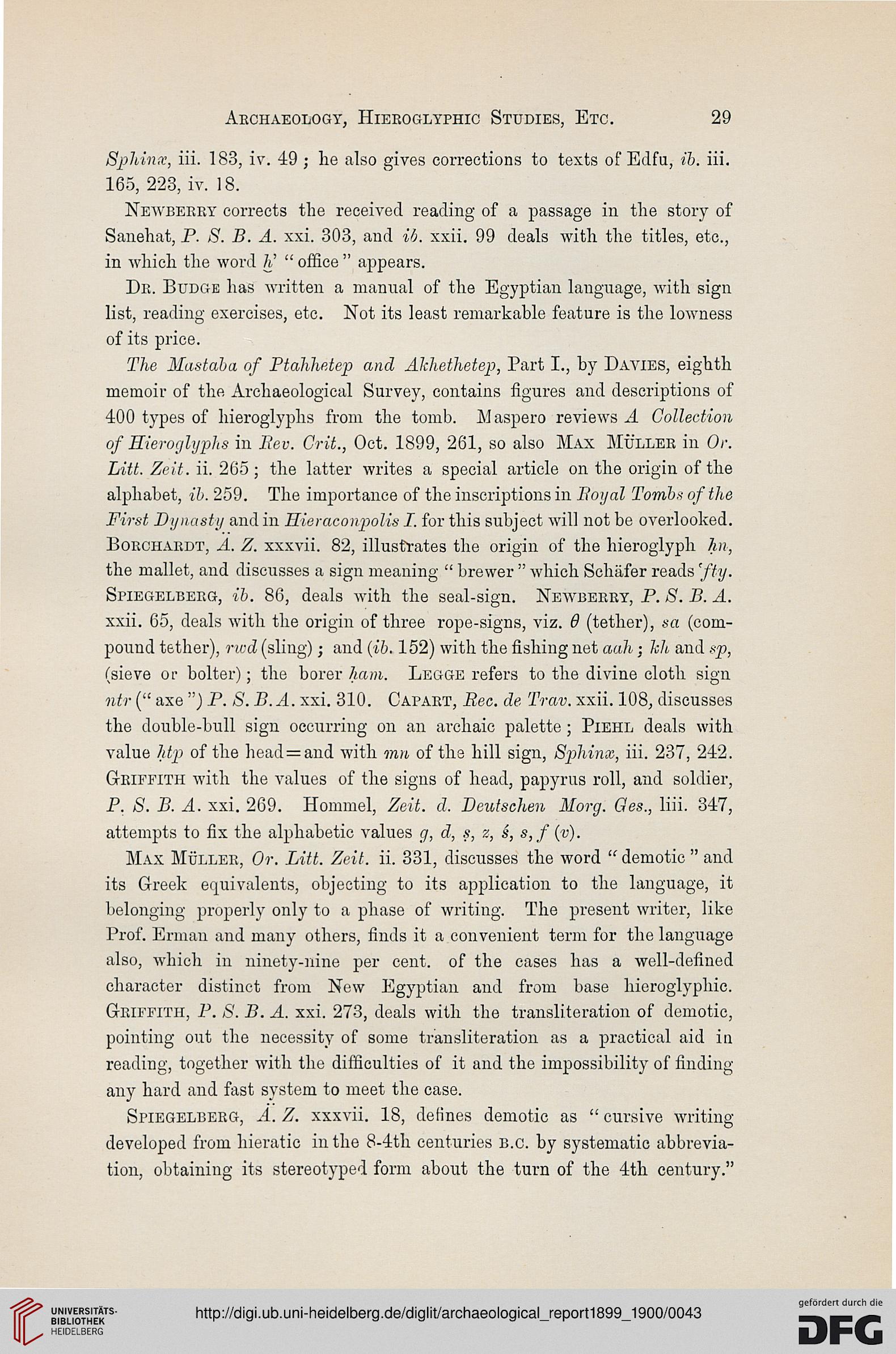Archaeology, Hieroglyphic Studies, Etc.
20
Sphinx, iii. 183, iv. 49; he also gives corrections to texts of Edfu, ib. iii.
165, 223, iv. 18.
Newberry corrects the received reading of a passage in the story of
Sanehat, P. 8. B. A. xxi. 303, and ib. xxii. 99 deals with the titles, etc.,
in which the word If " office " appears.
Dr. Budge has written a manual of the Egyptian language, with sign
list, reading exercises, etc. Not its least remarkable feature is the lowness
of its price.
The Mastaha of Ptahhetep and AJchethetep, Part I., by Davies, eighth
memoir of the Archaeological Survey, contains figures and descriptions of
400 types of hieroglyphs from the tomb. Maspero reviews A Collection
of Hieroglyphs in Rev. Grit., Oct. 1899, 261, so also Max Muller in Or.
Litt. Zeit. ii. 265 ; the latter writes a special article on the origin of the
alphabet, ib. 259. The importance of the inscriptions in Boijal Tomb* of the
First Dynasty and in Kieraconpolis I. for this subject will not be overlooked.
Borchardt, A. Z. xxxvii. 82, illustrates the origin of the hieroglyph hn,
the mallet, and discusses a sign meaning " brewer " which Schiifer reads 'fty.
Spiegelberg, ib. 86, deals with the seal-sign. Newberry, P. S. P>. A.
xxii. 65, deals with the origin of three rope-signs, viz. 6 (tether), sa (com-
pound tether), rwd (sling); and (ib. 152) with the fishing net aah; kh and sp,
(sieve or bolter); the borer ham. Legge refers to the divine cloth sign
ntr (" axe ") P. S. B.A. xxi. 310. Capart, Eec. de Trav. xxii. 108, discusses
the double-bull sign occurring on an archaic palette ; Piehl deals with
value Mp of the head = and with inn of the hill sign, Sphinx, iii. 237, 242.
Griffith with the values of the signs of head, papyrus roll, and soldier,
P. 8.B. A. xxi. 269. Hommel, Zeit. d. Dentschen Morg. Ges., liii. 347,
attempts to fix the alphabetic values g, d, s, z, s, s,f(v).
Max Muller, Or. Litt. Zeit. ii. 331, discusses the word " demotic " and
its Greek equivalents, objecting to its application to the language, it
belonging properly only to a phase of writing. The present writer, like
Prof. Erman and many others, finds it a convenient term for the language
also, which in ninety-nine per cent, of the cases has a well-defined
character distinct from New Egyptian and from base hieroglyphic.
Griffith, P. S. B. A. xxi. 273, deals with the transliteration of demotic,
pointing out the necessity of some transliteration as a practical aid in
reading, together with the difficulties of it and the impossibility of finding
any hard and fast system to meet the case.
Spiegelberg, A. Z. xxxvii. 18, defines demotic as " cursive writing-
developed from hieratic in the 8-4th centuries b.c. by systematic abbrevia-
tion, obtaining its stereotyped form about the turn of the 4th century."
20
Sphinx, iii. 183, iv. 49; he also gives corrections to texts of Edfu, ib. iii.
165, 223, iv. 18.
Newberry corrects the received reading of a passage in the story of
Sanehat, P. 8. B. A. xxi. 303, and ib. xxii. 99 deals with the titles, etc.,
in which the word If " office " appears.
Dr. Budge has written a manual of the Egyptian language, with sign
list, reading exercises, etc. Not its least remarkable feature is the lowness
of its price.
The Mastaha of Ptahhetep and AJchethetep, Part I., by Davies, eighth
memoir of the Archaeological Survey, contains figures and descriptions of
400 types of hieroglyphs from the tomb. Maspero reviews A Collection
of Hieroglyphs in Rev. Grit., Oct. 1899, 261, so also Max Muller in Or.
Litt. Zeit. ii. 265 ; the latter writes a special article on the origin of the
alphabet, ib. 259. The importance of the inscriptions in Boijal Tomb* of the
First Dynasty and in Kieraconpolis I. for this subject will not be overlooked.
Borchardt, A. Z. xxxvii. 82, illustrates the origin of the hieroglyph hn,
the mallet, and discusses a sign meaning " brewer " which Schiifer reads 'fty.
Spiegelberg, ib. 86, deals with the seal-sign. Newberry, P. S. P>. A.
xxii. 65, deals with the origin of three rope-signs, viz. 6 (tether), sa (com-
pound tether), rwd (sling); and (ib. 152) with the fishing net aah; kh and sp,
(sieve or bolter); the borer ham. Legge refers to the divine cloth sign
ntr (" axe ") P. S. B.A. xxi. 310. Capart, Eec. de Trav. xxii. 108, discusses
the double-bull sign occurring on an archaic palette ; Piehl deals with
value Mp of the head = and with inn of the hill sign, Sphinx, iii. 237, 242.
Griffith with the values of the signs of head, papyrus roll, and soldier,
P. 8.B. A. xxi. 269. Hommel, Zeit. d. Dentschen Morg. Ges., liii. 347,
attempts to fix the alphabetic values g, d, s, z, s, s,f(v).
Max Muller, Or. Litt. Zeit. ii. 331, discusses the word " demotic " and
its Greek equivalents, objecting to its application to the language, it
belonging properly only to a phase of writing. The present writer, like
Prof. Erman and many others, finds it a convenient term for the language
also, which in ninety-nine per cent, of the cases has a well-defined
character distinct from New Egyptian and from base hieroglyphic.
Griffith, P. S. B. A. xxi. 273, deals with the transliteration of demotic,
pointing out the necessity of some transliteration as a practical aid in
reading, together with the difficulties of it and the impossibility of finding
any hard and fast system to meet the case.
Spiegelberg, A. Z. xxxvii. 18, defines demotic as " cursive writing-
developed from hieratic in the 8-4th centuries b.c. by systematic abbrevia-
tion, obtaining its stereotyped form about the turn of the 4th century."




